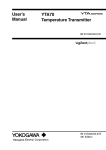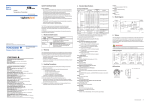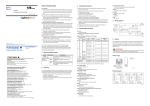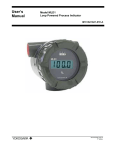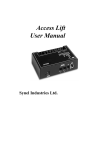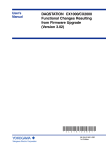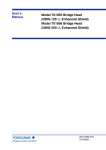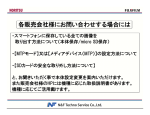Download User`s Manual
Transcript
Output Signal -E . . . . . . . . 4 to 20mA DC with digital communication (HART protocol) /KS2 CENELEC ATEX (KEMA) intrinsically safe approval /DS2 FM intrinsically safe/Nonincendive and CENELEC ATEX (KEMA) intrinsically safe approval combination IM 01C50C03-01EN 7th Edition /SS2 IECEx intrinsically safe, FM intrinsically safe/ Nonincendive, and CENELEC ATEX (KEMA) intrinsically safe approval combination 2. Warranty The warranty period of the instrument is as of condition shown when purchasing. Any trouble arising during the warranty period shall be replaced at free of charge. The following problems or troubles shall not be eligible of charge-exempt repair. • Caused by improper usage or storage of the customer which exceeds the specification requirements. • Caused by mishandling or modification. • Caused by fire, earthquake or other acts of God that are not directly a result of problems of the instrument. YOKOGAWA ELECTRIC CORPORATION Headquarters 2-9-32, Nakacho, Musashino-shi, Tokyo, 180-8750 JAPAN Branch Sales Offices Nagoya, Osaka, Hiroshima, Fukuoka, Sendai, Ichihara, Toyota, Kanazawa, and Kitakyusyu. YOKOGAWA CORPORATION OF AMERICA 2 Dart Road, Newnan, Georgia 30265-1094, U.S.A. Phone : 1-800-888-6400 Fax : 1-770-254-0928 3. Handling Precautions YOKOGAWA EUROPE B. V. Euroweg 2, 3825 HD Amersfoort, THE NETHERLANDS Phone : 31-88-4641000 Fax : 31-88-4641111 Branch Sales Offices / Wien (Austria), Zaventem (Belgium), Ratingen (Germany), Madrid (Spain), Runcorn (United Kingdom), Milano (Italy), Velizy-Villacoublay (France), Budapest (Hungary), Stockholm (Sweden), Sola (Norway), Warszawa (Poland), Vila Nova de Gaia (Portugal), Bucharest (Romania), Dublin (Ireland) (1) Read this manual throughly and carefully before handling the instruments. Observe the instructions. (2) Store the product in location that meets the following requirements. • No exposure to rain or water • No major mechanical vibration or shock • Humidity and Temperature limitations • Ordinary conditions(25°C, 65%) is preferable. Otherwise, as of specified in “Standard Specifications.” (3) Avoid corrosive atmosphere for storage and installation. (4) For safe installation of the transmitter in hazardous area, the following must be observed. The module must only be installed by qualified personnels who are familiar with the national and international laws, directives, and standards that apply to this area. (5) Yokogawa will not be liable for malfunctions or damage resulting from any modification made to this instrument by the customer. YOKOGAWA AMERICA DO SUL LTDA. Praca Acapulco, 31 - Santo Amaro. Sao Paulo/SP - BRAZIL Phone : 55-11-5681-2400 Fax : 55-11-5681-4434 YOKOGAWA ELECTRIC ASIA PTE. LTD. 5 Bedok South Road, 469270 SINGAPORE Phone : 65-6241-9933 Fax : 65-6241-2606 YOKOGAWA ELECTRIC KOREA CO., LTD. 14-1, Yangpyongdong-4Ga, Youngdeungpo-Gu, Seoul, 150-866 KOREA Phone : 82-2-2628-6000 Fax : 82-2-2628-6400 YOKOGAWA AUSTRALIA PTY. LTD. Tower A, 112-118 Talavera Road, Macquarie Park, N.S.W.2113, AUSTRALIA Phone : 61-2-8870-1100 Fax : 61-2-8870-1111 YOKOGAWA INDIA LTD. Plot No.96 Electronic City Complex, Hosur Road, Bangalore 560100, INDIA Phone : 91-80-4158-6000 Fax : 91-80-2852-1442 YOKOGAWA CHINA CO., LTD. 3F TowerD Cartelo Crocodile Building No.568 West Tianshan Road, Shanghai 200335, CHINA Phone : 86-21-62396262 Fax : 86-21-62387866 360 90 90 90 180 360 360 90 90 135 360 360 -200 to 850 -328 to 1562 -60 to 250 -76 to 482 -800 to 800 [mV] 10 18 10 18 2.5 [mV] 0 to 7000 [Ω] 25 [Ω] ±0.1% of span or ±1.0°C ±0.1% of span or ±0.5°C 3 2 + + mV - 1 6 5 4 mA Int. CJC - supply + 8–35VDC MUX HART CPU Comm. A/D PGA 0_16 mA D/A 4 3 EEPROM ±0.1% of span or ±1.0°C 2 supply 4–20 mA A YTA70 ±0.1% of span or ±0.5°C F01E.ai ±0.1% of span or ±1.0°C 6. Wiring ±0.1% of span or ±0.1°C ±0.1% of span or ±0.2°C ±0.1% of span or ±0.01mV ±0.1% of span or ±0.1Ω See wiring diagram. For output signal, use twisted pair or cables with performance equivalent to 600V vinyl insulate cable. For wiring in high or low temperature, use a wire or cable suitable for such temperature. Use cables and wires which meet atmospheric conditions. Take necessary measure to avoid corrosion or damage of cables and wires. Cold Junction Compensation Accuracy(For T/C only) ±1°C (±1.8°F) Ambient Temperature Effects (per 10°C Change) For E, J, K, L, N, T and U thermocouple inputs: ±0.05% of span or ±0.25°C, whichever is greater For R, S, B, W3 and W5 thermocouple inputs: ±0.05% of span or ±1°C, whichever is greater For Pt100 and Ni100 RTD inputs: ±0.05% of span or ±0.05°C, whichever is greater For DC voltage input: ±0.05% of span or ±5µV, whichever is greater For Resistance(ohm) input: ±0.05% of span or ±0.05Ω, whichever is greater Power Supply Effects ±0.005% of FS per Volt RFI Effects Tested per EN 61326, field intensity up to 10 V/m. EMC Conformity EN 61326 Maximum Zero Offset ±50% of the maximum temperature Input Signal Source Resistance (for T/C input) 10 MΩ, or 3 kΩ at power-off Input Lead Wire Resistance (for RTD input) 5 Ω per wire or lower Burnout High(NAMUR NE43 upscale) , Low(NAMUR NE43 downscale) or value within 3.5 to 20 mA Output Two wire 4 to 20 mA DC Response Time 1 to 60 sec programmable Ambient Temperature Limits (Option code may affect limit) –40 to 85°C (–40 to 185°F) Ambient Humidity Limits 5 to 90% RH at 40°C (104°F) Supply Voltage 8 to 35 V DC 8 to 30 V DC for Intrinsically safe type 13.8 to 35 V DC for digital communication Load Resistance Limitation: 0 to (E–8)/0.0236 [Ω], where E is power supply voltage. Isolation Input/output isolated to 1500 V AC. Mounting DIN form B head mounting Terminals M3 screws Weight 50 g (0.11 lb) IMPORTANT When mounting on a sensor head, do not overtighten the screws. n Wiring Diagram (+) 1 2 3 4 5 6 1 2 3 4 5 6 SUPPLY (–) (–) (+) T/C or DC milivolts (+) (B) SUPPLY (–) (A) Two-wire RTD or ohm 1 2 3 4 5 6 (+) 1 2 3 4 5 6 SUPPLY (–) (B) (B) (A) Three-wire RTD or ohm (+) (B) (B) (A) SUPPLY (–) (A) Four-wire RTD or ohm F02E.ai n Dimensions Unit : mm (approx. inch) Ø6 ) (0.24 Ø 44 (1.73) Temperature Transmitter 200 50 50 50 100 200 200 50 50 75 200 200 4 2 .......... 752 to 3308 -148 to 1832 -148 to 2192 -292 to 2502 -292 to 2372 -58 to 3200 -58 to 3200 -328 to 752 -148 to 1652 -328 to 1112 32 to 4172 32 to 4172 RTD.lin.R -Wire TC − YTA70 Optional Specifications 7th Edition: July 2011 (YK) All Rights Reserved, Copyright © 1999, Yokogawa Electric Corporation Descriptions 400 to 1820 -100 to 1000 -100 to 1200 -180 to 1372 -180 to 1300 -50 to 1760 -50 to 1760 -200 to 400 -100 to 900 -200 to 600 0 to 2300 0 to 2300 (value whichever is greater) mV + Suffix code Resistance °F Accuracy 1 Model <T/C> B IEC584 E J K N R S T L DIN43710 U W3 ASTM W5 <RTD> Pt100 IEC751 Ni100 DIN43760 DC Voltage °C Minimum span °C °F 3 1. Model and Suffix Codes Standard Input ranges 4 The YTA70 is a head mount type of temperature transmitter that accepts thermocouple or RTD input and converts it to a 4 to 20 mA DC signal for transmission. The YTA70 specifies HART communication protocol for remote configuration. It is imperative that usres observe the instructions in this manual to ensure the protection and safety of operators. Sensor type 3 Accuracy (see table below) − Ex/I.S. installation: • For correct use and installation the manufacturer’s manual must be followed. When programming the Transmitter by PC and communication interface or a HART® terminal the intrinsically safe data shall be observed. • The designation galvanic isolation between the transducer input and the loop supply indicates signal isolation only. It shall not be interpreted as an Intrinsically Safe galvanic isolation like an isolating barrier. Therefore ordinary care in selecting barrier and grounding shall be considered. • The apparatus must be installed in an enclosure with an Ingress Protection of at least IP 20. • The terminals 1 and 2 of the equipment have to be electrically connected to a linear barrier located in the non hazardous area. • For Ex/I.S. data, see chapter 7. Approvals Options. 5. Block Diagram + IM 01C50C03-01EN 4. Standard Specifications 5 YTA70 Temperature Transmitter SAFETY INSTRUCTIONS 6 User’s Manual 33 (1.30) 20.2 (0.80) F03E.ai 7. Approvals Options 7.1 CENELEC ATEX (KEMA) Intrinsically safe model (/KS2, /DS2, /SS2) ATEX Certificate: KEMA 10 ATEX0027 Applicable Standard: EN 60079-0: 2006, EN 60079-11: 2007, EN 60079-26: 2007, EN 61241-0: 2006, EN 61241-11: 2006 [ Installation diagram ] Hazardous Area Zone 0, 1, 2, 20, 21, 22 T4: -40 ≤ Ta ≤ 85°C T6: -40 ≤ Ta ≤ 60°C Terminal: 3, 4, 5, 6 Uo: 9.6 VDC Io: 28 mA Po: 67 mW Lo: 35 mH Co: 3.5 μF Non-hazardous Area 1+ 6 5 4 2- 3 YTA70 Terminal: 1, 2 Ui: 30 VDC Ii: 120 mA Pi: 0.84 W Li: 10 μ H Ci: 1.0 nF Barrier F04E.ai June '10 1 8. HART Communication Maximum Ambient Temperature for gas-proof For T4: 85°C, For T6: 60°C Maximum Surface Temperature for dust-proof For T4: T105°C (Ambient Temperature: –40 to 85°C) For T6: T85°C (Ambient Temperature: –40 to 60°C) Applicable Standard: FM 3600, FM 3610, FM 3611, FM 3810 Installation diagram A standard HART communicator can be used for programming the YTA70. The HART communicator must be loaded with the appropriate DDL driver for YTA70. 1+ 5 sensor Ambient temperature limits T4: -40 to +85 deg. Celcius T6: -40 to +60 deg. Celcius 6 YTA70 4 2- 3 Terminal 3,4,5,6 Vt or Uo: 9.6 V It or Io: 28 mA Pt or Po: 67.2 mW Ca or Co: 3.5 uF La or Lo: 35 mH Terminal: 1 , 2 Vmax or Ui: 30 V Imax or Ii: 120 mA Pmax or Pi: 0.84 W Ci: 1 nF Li: 10 uH UM ≤ 250V Voc or Uo ≤ Vmax or Ui Isc or Io ≤ Imax or Ii Po ≤ Pi Ca or Co ≥ Ci + C cable La or Lo ≥ Li + L cable This device must not be connected to any associated apparatus which uses or generates more than 250 VRMS Relaying terminals + − Non-hazardous Location Hazardous (Classified) Location Class I,Division2, Groups, A,B,C,D Class I, Zone 2, IIC Associated Apparatus or Barrier 2- Voc or Vt ≤ Vmax Ca ≥ Ci + C cable La ≥ Li + L cable 5 sensor Ambient temperature limits T4: -40 to +85 deg. Celcius T6: -40 to +60 deg. Celcius 1+ YTA70 4 3 This device must not be connected to any associated apparatus which uses or generates more than 250 VRMS Terminal: 1 , 2 Vmax: 35 V Ci: 0 μ F Li: 10 uH Sensor Setup T4: -40 ≤ Ta ≤ 85°C T6: -40 ≤ Ta ≤ 45°C Terminal: 3, 4, 5, 6 Uo: 9.6 VDC Io: 28 mA Po: 67 mW Lo: 35 mH Co: 3.5 μF 250 (Diag/Service) 2.Diag/ Service 2.Loop test 4.Write Protection Online Menu 4 1.Device setup 2.PV 3.Electr 4.Snsr1 5.PV AO 6.PV %rnge 2Terminal: 1, 2 Ui: 30 VDC Ii: 120 mA Pi: 0.84 W Li: 10 μ H Ci: 1.0 nF 1.Status 3.Calibration 5 YTA70 Barrier — Output value in mA — PV % rnge Output value with respect to the range in % — PV Log Read max/min log Reads the maximum/minimum PV — stored in the memory Range value Reset max/min Clears the PV maximum/minimum — log and restart logging PV LRV/PV URV Lower/upper range value to defines the 0%/100% value of the measurement 5.Read max/min log 6.Reset max/min (Basic Setup) 3.Basic Setup 1.Tag 2.Range values 3.Sensor config 4.PV Damp 5.Snsr s/n (Detailed setup) F06E.ai 4.Detailed Setup 1.Sensors 2.Signal condition 3.Output condition 5.Review 4.Device information Shows the max./min. usable value — for upper/lower range value Unit °C Engineering unit to be displayed with such digital value as PV, URV, LRV, USL, LSL,min.span, etc. PV unit 1.Sensor errors 2.ADC errors 3.Misc. errors (Calibration) 1.Range values 2.D/A trim 3.Scaled D/A trim 4.Override D/A trim Output Condition (Range values) 1.PV LRV 2.PV URV 3.PV unit 4.LSL 5.USL 1.Write protect 2.New password (Range values) 1.PV LRV 2.PV URV 3.PV unit 4.LSL 5.USL (Sensors) 1.Process sensor 2.Electr (Cable resistance) 1.Enter value 2.Measure value (Process sensor) 1.PV 2.Snsr1 3.PV unit 4.Sensor setup 5.Sensor info (Analog output) 1.PV AO 2.Output rnge (Signal condition) 1.PV LRV 2.PV URV 3.PV unit 3.Sensor error 4.PV % rnge values 5.PV Damp 4.Loop test 5.Scaled (Output condition) D/A trim 6.D/A trim 1.Analog 7.Override output D/A trim 2.HART output 1.USL 2.LSL 3.Min span (Output range) 1.AO 0% 2.AO 100% 3.AO lo lim 4.AO up lim (Sensor error values) 1.Broken sensor 2.Shorted sensor (HART output) 1.Poll addr 2.Num req preams 3.Num resp preams (Broken/shorted sensor) 1.Br(Sh) sensor 2.NAMUR down 3.NAMUR up F09E.ai Calibration Write protection Apply trim Clear trim Device information Initial Setting Selection/Setting Range Write protect Write-protects the device, if correct Not password is entered. *2 protected New password Sets a new password for wirte protection, if correct password is entered. D/A trim Allows the calibration of a selected — analog output with an external reference at the operating endpoint. Scaled D/A trim Allows the calibration of the analog — output with the external reference which is scaled at 0 to 100%. Override D/A trim Overrides any previous D/A trimming by restoring factory calibration values. — Manufacturer Manufacturer identification code Yokogawa Model Model name YTA70-E TAG Tag number, up to 8 alphanumerical characters. — Descriptor Text which can be used by user in — any way. Up to 16 alpha-numerical characters Message Text which can be used by user in — any way. Up to 32 alpha-numerical characters Date Date information. MM/DD/YY. Not inclemented. The date is updated whenever changing configuration via PC configurator. Factory calibration date — Damping PV Damp Damping time constant in seconds 0.43(s) *1 applied to the digital value. 0 to 62.5(s) Sensor config Sensor type (wire, unit) Sensor type and related settings. [When T/C or milivolts is selected] Always select “single” for a measurement type. [When RTD or ohm is selected] Always select 2-, 3- or 4-wire but others for the number of sensor wires. Pt100 3-wire °C *1 RTD factor For RTD only. Leave it to “1.” 1 Write protect Cold Junction Compensation For T/C only. Always leave it to “1.internal sensor.” Internal sensor Indicates whether the device is write-proteced. Not protected Snsr s/n Not used. 0 Error detection Type of sensor errors to be detected for burnout operation. (1)No test performed, (2)broken sensor, (3)shorted sensor*3, or (4)broken & shorted*3 broken sensor Final assembly number Not used. 0 Distributor — Yokogawa Revision #'s Software/hardware revision number — Status Error stauts (see “Error status” in this table.) — Input info List of input variables — Output info List of output variables — Enter value Enter new value of the RTD/ohm 5 (ohm) cable resistance for compensation. Measure value Actually measure the cable resistance of 2-wire RTD/ohm for compensation. — — Minimum span limit Min.span Minimum settable span Analog Output range AO 0%(100%) Output value for 0%(100%) in mA. 4(0%) 20(100%) AO lo(up) lim Output lower(upper) limit in mA. NAMUR, or 3.8 to 23mA NAMUR Sensor Error values Enter or select the output value when sensor error is detected. NAMUR upscale, NAMUR downscale, or value within 3.5 to 23mA NAMUR upscale [high] *1 Loop test Change the output manually for testing the loop. 4mA, 20mA, or value within 3.5 to 23mA — (Sensor setup) 1.Sensor config 2.Error detection 3.Cable resistance 4.Snsr s/n HART Communicator Item LRV: 0 URV:100 *1 Range Limit LSL/USL Cable resistance (Device setup) (Process Variables) 1.PV 1.Process 2.Electr Variable 3.Snsr1 4.PV AO 5.PV % rnge (Status) 1+ 3 Terminal temperature PV AO Sensor Errors F08E.EPS 8.2 Parameters Non-hazardous Area 6 Electr Digital Communication range Communication requirement Certificate No.: IECEx KEM 10.0086 Applicable Standard: IEC 60079-0:2007-10, IEC 60079-11:2006, IEC 60079-26:2006, IEC 61241-11:2005 Zone 0, 1, 2, 20, 21, 22 E-8 0.0236 8.0 13.8 21.8 35.0 Power supply voltage E (V DC) 7.3 IECEx Scheme Intrinsically safe model (/SS2) Measured variables in engineering — unit. F07E.ai 600 F05E.ai [ Installation diagram ] Hazardous Area HART communicator Connection R (Ω) 6 HART communicator HART communicator Initial Setting Selection/Setting Range PV Distributor YTA70 External load resistance HART Communicator Output value Terminal board Signal Condition R= [ Nonincendive ] Process Variable Control room Non-hazardous Location Associated Apparatus or Barrier with entity Parameters: Process Variable Minimum loop resistance is 250Ω. If the receiving equipment has a lower resistance, a serial resistor must be inserted to communicate with the HART communicator. [ Intrinsically safe ] Class I,Division1, Groups, A,B,C,D Class II Division 1 Groups E,F,G or Class I, Zone 0, IIC Item 8.1 Connection and Requirements 7.2 FM Intrinsically safe/Nonincendive model (/DS2, /SS2) Hazardous (Classified) Location Parameters List Diagnostics Error status Sensor errors ADC errors Misc. errors Device information See “Device information” in this table. — *1: Or as specified upon ordering. *2: The initial setting of password upon shipment is "********". *3: With T/C or milivolts for sensor type, the alarm is generated when the input signal drops down below 2.5 mV. Revision Record — Show error status related to a sensor. When any one of the errors turns "ON", check the sensor and wiring. Show error status related to analog to digital conversion. When any one of the errors turns "ON", Repower the device. If error remains, replace the device. Review — — Show error status related to a device. When any one of the errors turns "ON", Re-power the device. If error remains, replace the device. ● Manual No. : IM 01C50C03-01EN ● Title : YTA70 Temperature Transmitter Edition Date Page 1st Mar. 1999 — New Publication. 2nd June 1999 1 6 10 Add code "/DS1" in the table Add "7.2 FM intrinsically safe model" Add "note 2" . 3rd Feb. 2000 2,3 4 9 11 Revise accuracy & temperature effect. Correct "Isolation". Add explanation Add "Note". 4th Mar. 2002 1 5th July 2003 1,5,6 Delete code "/KS1" and "/DS1". 6th Feb. 2007 2,3,6 Add handling precaution. Change specifications of FM Intrinsically safe model. 7th July 2011 2 Revised item Change Optional code KS1 and DS1 to KS2 and DS2 respectively. Add description(4) based on ATEX directives. Change marking for KS2 and DS2. Change Certificate number and applicable standard. Change electrical data. Add 7.3 IECEx scheme approval. 2



